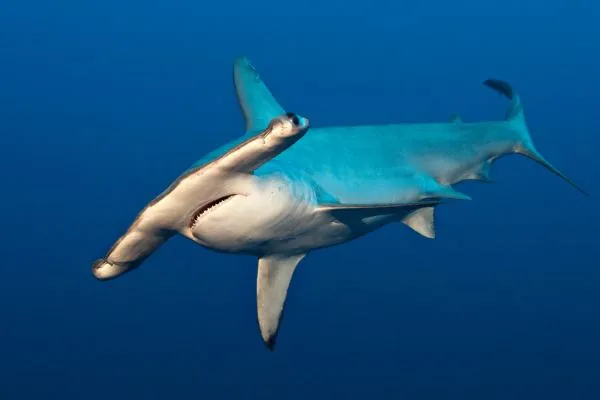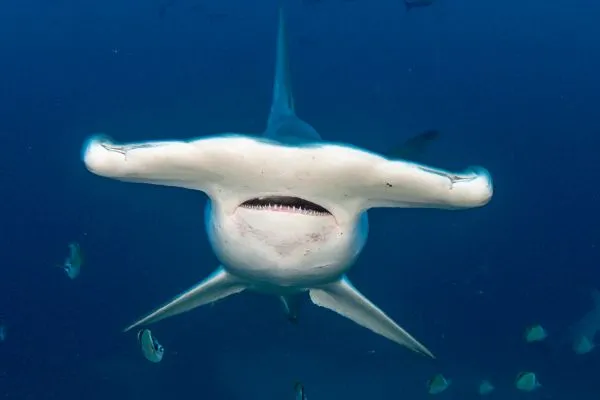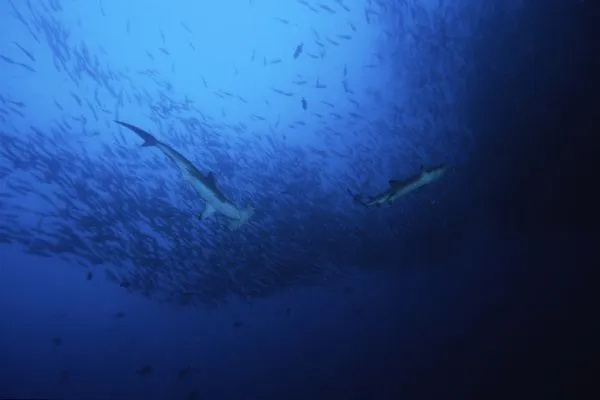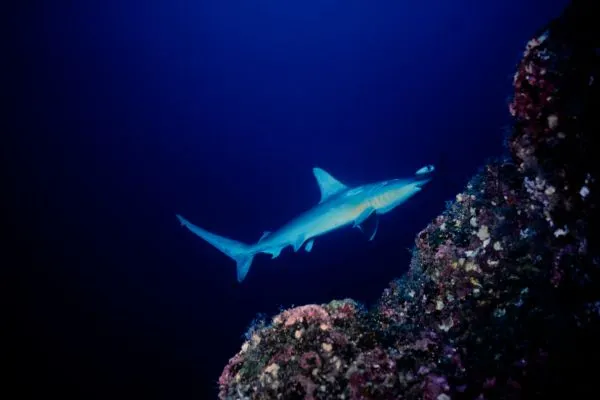While hammerheads stand out as one of the most recognisable shark species, there's much more to this species than meets the eye.

What is a scalloped hammerhead shark?
With just over 500 different species of shark classified, and a further two dozen waiting to be formally scientifically named, shark taxonomy is not for the faint-hearted. But there is one group that surely everyone would immediately recognise: the hammerheads.
Sporting a wide, flattened head that is uniquely shaped like a double-headed hammer, it’s not hard to see how these sharks got their name. The eyes and nostrils are located at either end of the ‘hammer’ – or cephalofoil, as it’s technically called.
Why are scalloped hammerhead sharks shaped like that?
Of the nine species of hammerhead, the ‘scalloped’ can be distinguished by the notches along the leading edge of its cephalofoil, which produce a distinct scalloping effect. The females tend to be larger than the males – and the species’ bronze-grey back and white underside help camouflage the shark from prey and potential predators, both above and below in the water column.

The explanation behind the shape of the hammerhead’s head has long been debated. While undoubtedly giving the sharks extra lift, the cephalofoil may also help them make sharper turns in the water.
The widely spaced eyes allow for effective stereoscopic vision, while the head’s broad shape also houses a sense organ known as the ampullae of Lorenzini. Packed with electroreceptors and operating like an underwater metal detector, it helps the sharks to detect prey hidden on or just under the sea-floor sediment.
Hammerheads have 360º vision in the vertical plane, able to take in their surroundings both above and below.
Another possible function for the hammerhead's head is to help pin down any slippery prey unearthed from the seabed. Once secured, the shark’s finely serrated teeth then act as knives and forks, allowing the prey to be either swallowed whole or dismembered in bite- sized chunks.
How big are scalloped hammerhead sharks?
Born at around 50cm, males mature to about 1.4-1.65 metres, while females reach just over two metres. However, the maximum length for this shark is between 3.7-4.2 metres.
Why do hammerheads swim in shoals?
While it can be relatively easily observed at a number of sites, particularly around seamounts (submarine mountains), there are only a few places where it gathers in large numbers. As most apex predators operate either as ‘lone wolves’ or in small cohorts, this is considered highly unusual behaviour. These groups, or ‘shivers’, of sharks tend to consist mostly of females, with the males remaining out in deeper waters.
At locations such as the Galápagos, numbers can reach into the hundreds or even, on occasion, thousands. As the sharks tend to congregate relatively close to the water’s surface, this is one marine spectacle where a mask, fins and snorkel, rather than a full scuba kit, will often suffice.
BBC Earth's short film about scalloped hammerhead sharks
Watch this stunning footage, which delighted the BBC Earth film crew. It takes a closer look at male and female hammerhead shark's intriguing mating behaviour.
That was a good morning in the office
Shark researcher, Alex Hearn after diving with hammerhead sharks for BBC Earth
No time to see it all? Don't miss the wonderful highlight around 1:30 mins in.
Where do scalloped hammerhead sharks live?
Though widespread, the scalloped hammerhead is most commonly encountered in the Hammerhead Triangle, situated between the islands of Cocos, Malpelo and the Galápagos in the eastern Pacific.
Where to see scalloped hammerhead sharks
- Socorro Island, Mexico: South of Baja California, it’s a hotspot not just for scalloped hammerheads, but also yellowfin tuna and giant oceanic manta rays
- Cocos Island, Costa Rica: Situated some 36 hours by boat from the mainland, the waters around Cocos are designated as a marine national park
- Alphonse Atoll, Seychelles: The tropical waters around these islands host world-class snorkelling and diving, with shoals of hammerheads
- Galápagos Islands, Ecuador: Scalloped hammerheads are best seen around Darwin and Wolf, though they can be encountered all around the archipelago
- Rangiroa, French Polynesia: January and February are ideal months to see dozens of scalloped hammerheads hunting stingrays at Tiputa Pass
At the Galápagos, numbers can reach into the hundreds or thousands
What do scalloped hammerhead sharks eat?

Stingrays are among scalloped hammerheads’ favoured prey, but one shark was seen with 96 venomous stingray barbs embedded in its mouth and jaws, suggesting that being stung must be a hazard. They also eat bony fishes, sharks and invertebrates.
Can scalloped hammerheads regulate their body temperature?
In 2023, researchers reported in the online journal, Science, that the sharks may hold their breath as they dive, closing their gills and mouths to retain body heat. This novel technique, if confirmed, could revolutionise our understanding of how sharks regulate temperature.
It’s an astounding and a completely unexpected surprise.
Mark Royer, marine biologist at the University of Hawaii at Manoa
Mark Royer, a marine biologist at the University of Hawaii at Manoa, and his team attached sensors to the sharks off the coast of Oahu. The data revealed that the sharks maintained their body temperature within 0.1°C during dives, suggesting breath-holding as a strategy for staying warm. As they neared the surface, their body temperature dipped slightly, likely due to re-opening their gills to breathe.

Described by Royer as "An astounding and a completely unexpected surprise," this discovery marks the scalloped hammerhead shark as the first deep-diving fish known to hold its breath. The data Royer and his team collected revealed that the sharks held their breath an average of 17 minutes per dive.
But evidence, such as video footage of gills and mouth closure, is needed to confirm the theory. Royer's team aims to explore the sharks' metabolism further to unravel the mysteries of their deepwater dives, shedding light on the extraordinary abilities of these enigmatic creatures.
Are scalloped hammerhead sharks dangerous?
Scalloped hammerheads are not considered a danger to either divers or snorkelers, but are nonetheless quite skittish and can move surprisingly quickly, so it’s always best to give them space. Anyone who has spent time in the water with this species will testify that a calm, careful approach invariably gets the best results.
How long is the gestation period for scalloped hammerheads?
Scalloped hammerheads reproduce in viviparous fashion, meaning that around 12 to 38 embryos are nourished by a placental link to their mother, not unlike a mammal’s umbilical cord.
After a gestation period lasting up to 12 months, the young are then born as fully independent and miniature versions of their parents.
Why is the scalloped hammerhead shark endangered?
With its fins highly prized as the key ingredient in shark-fin soup, it’s no surprise that the scalloped hammerhead has experienced a dramatic population decline. This has resulted in the species now being classified as globally Endangered and placed on Appendix II of CITES (Convention on International Trade in Endangered Species of Wild Fauna and Flora), meaning its trade must be controlled.
Any sharks caught are often subjected to the frankly gruesome treatment of ‘finning’, whereby fins are sliced off and the bodies discarded overboard. Added to this, the shark is often the victim of fishing bycatch via trawl-nets, purse-seine nets, gill nets and longlines.
However, with hammerheads consistently ranking among the world’s top underwater wildlife attractions, shark tourism now contributes millions towards regional economies, thereby presenting a sustainable alternative to fishing them into oblivion. Presumably those enjoying this magnificent spectacle agree that the fins look far better on the sharks than they do floating in a bowl of soup.
Find out more
Check out our expert guides to other shark species, including the blue shark, whale sharks and basking sharks.

